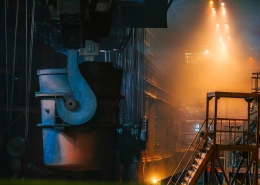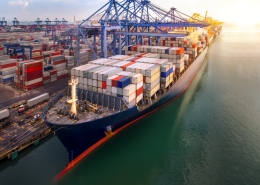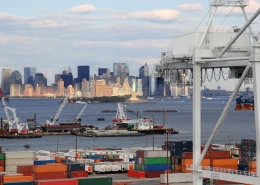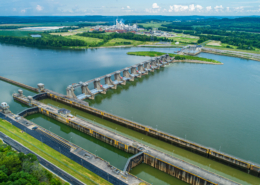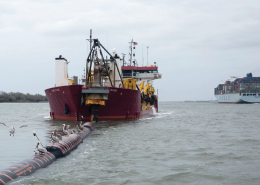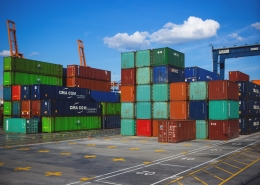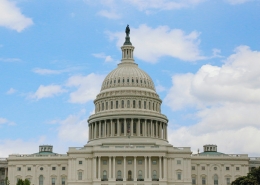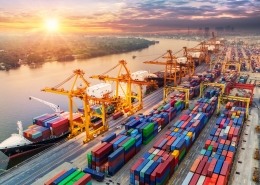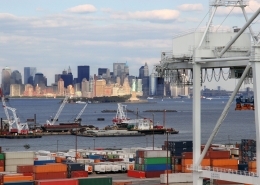The U.S. House Transportation and Infrastructure Subcommittee on Railroads, Pipelines, and Hazardous Materials met for a hearing titled “Examining Challenges and Solutions in the Commuter Rail Industry.” The subcommittee called on several witnesses to provide insights into the current landscape of commuter rail and address key opportunities in commuter rail policy.
Witness List
Mike Noland, President, Northern Indiana Commuter Transportation District
Debra Johnson, General Manager and CEO, RTD-Denver
David W. Dech, Executive Director, South Florida Regional Transportation Authority/ Tri-Rail
Kevin Corbett, President and CEO, New Jersey Transit on behalf of the Northeast Corridor Commission
Darren Kettle, CEO, Metrolink
Overview of Commuter Rail
Commuter rail in the United States can be defined as passenger rail service that connects city centers with surrounding suburban, ex-urban, commuter towns, and rural areas, within a metropolitan area. Traditionally, a defining characteristic of commuter rail service was passenger rail service that brought commuters from outer areas into the city in the mornings and commuters out of the city in the evenings.
(Ed. Note: The difference between commuter rail and other mass transit service is also a legal one – 49 U.S.C. §20102 effectively defines commuter rail subject to Federal Railroad Administration safety jurisdiction as being “connected to the general railroad system of transportation.” If the service is provided on tracks that are, or were, part of the national railroad network, it’s commuter rail and it’s FRA jurisdiction. If it’s a purpose-built rail system that has never connected with the freight system, then it’s exempt from FRA safety oversight.)
However, millions of passengers take commuter rail not only for work, but for leisure, school, daily errands, and other purposes. There are 31 commuter rail services across the United States, ranging from large agencies like NJ Transit, SEPTA (Southeastern Pennsylvania Transportation Authority), and Metrolink serving massive metropolitan areas to smaller services like SunRail in Orlando or the Music City Star in Nashville.
The Covid-19 pandemic brought significant challenges to the world of commuter rail. According to a 2021 GAO report, commuter rail ridership nationwide declined by around 79 percent between September 2019 and September 2020. Public transportation in general took a hit during the pandemic, but the nature of commuter rail as a service bringing commuters to and from the city made it so that commuter rail was especially hard hit by the pandemic. Work from home trends and reduced activity in city centers took most of the ridership that uses commuter rail.
Yet, as society emerges from Covid-19 pandemic, commuter rail systems nationwide are returning to pre-pandemic ridership levels. Tri-Rail, which serves the Miami metro area reached pre-pandemic ridership levels in March 2024. As commuter rail service and ridership begin to return, commuter rail agencies are having to contend with funding issues, changing ridership trends, and aging infrastructure.
Throughout the hearing, representatives and witnesses highlighted the following themes: Improvement/modernization issues, relations with Amtrak, safety concerns, and insurance issues.
Improvement and Modernization
Commuter rail service is not a relic of the past. While commuter rail took a hit during the pandemic, ridership is increasing and many cities across the country are seeing growing populations that may benefit from improved public transportation options. Rep. Valerie Foushee (D-NC) noted the need to provide mobility options like commuter rail, especially in North Carolina.
The Carolinian and Piedmont passenger rail services carry 600,000 North Carolinians. The Research Triangle, which encompasses Raleigh, Durham, and Chapel Hill is witnessing a massive growth in population, and the Rep. Foushee noted that projects like the S-Line connecting Raleigh and Richmond and potential commuter rail for the Triangle, which seeks to improve commuter and passenger rail, would benefit the the state.
Improving existing commuter rail services or establishing new services requires a lot of funding. Full committee ranking member Rep. Rick Larsen (D-WA) praised the significant boost in passenger rail funding provided by the Infrastructure Investment and Jobs Act (IIJA). As Larsen mentioned, the billions of dollars set aside for the Capital Investments Grant program provide important funding that commuter rail agencies have access to. However, several of the witnesses and representatives noted that compared to other forms of public transportation, commuter rail agencies do not have as much access to federal dollars.
Debra Johnson highlighted that Amtrak and short line railroads are directly eligible for funding from the Consolidated Rail Infrastructure and Safety Improvements grant program, but commuter rail agencies are not. Corbett and Kettle echoed the importance of increasing commuter rail agencies’ access to federal funds. Commuter rail agencies rely on farebox revenues and support from state, local, and federal funding to cover capital and operational costs. With the massive increase in federal funding, the witnesses urged the subcommittee to consider ways to increase commuter rail agency access to federal dollars.
The change in work and commuting patterns is top of mind in the commuter rail industry. The witnesses discussed how commuter rail agencies ought to consider adapting business models to provide service beyond the traditional morning and evening peak hours.
Kettle noted in response to questions from Rep. Henry Johnson (D-GA) and Rep. Mark DeSaulnier (D-CA) that people are using commuter rail during all hours of the day, and building a commuter service for the traditional commuter serves mostly white-collar workers. Kettle noted the importance of providing midday, evening, and weekend service so that more of the population can have access to commuter rail as a viable form of transportation.
Responding to Rep. Jesus Garcia (D-IL), Noland highlighted the benefit of double tracking the South Shore commuter line, serving the communities between South Bend, IN and Chicago, IL. With the double track in place, the commuter rail line can provide additional service, relieve congestion, and provide service during off-peak and weekend hours.
Adapting to changing traveling patterns includes attracting more riders. Responding to Rep. Grace Napolitano (D-CA), Kettle touched on strategies to increase commuter rail access for disadvantaged communities including discounted rates and working with home builders to connect commuter rail service with more affordable housing.
Rep. Seth Moulton (D-MA) provided insight on modernizing commuter rail across the country. Aging rolling stock, aging track and signaling infrastructure and historic under investment have created an environment where commuter rail is falling behind. Poor infrastructure restricts train speeds, leaving commuter rail in the dust of highways and air travel.
Dozens of NJ Transit commuter trains run daily, carrying thousands of passengers and Corbett noted that delays of even ten minutes along the Northeast Corridor can cause significant back-ups.
Other improvements for commuter rail included investments in low or zero-emissions locomotives. Kettle discussed how investments in low or zero-emissions locomotives is an action commuter rail agencies can take to address the low air quality in cities.
Responding to Rep. Foushee, Corbett noted that having regional commissions like the Northeast Corridor Commission could be beneficial in creating good commuter rail policy, citing the Northeast Corridor Commission as a potential model for other regional commissions.
Relations with Amtrak
The relationship between commuter rail and Amtrak emerged as a topic of conversation several times during the hearing. The witnesses voiced concerns about Amtrak’s right of track preference and statutory powers that could impact commuter rail service. The issue emerged in the context of the new double tracked section of the South Shore commuter line, set to open in May 2024. Currently, Amtrak runs its passenger services along the Norfolk Southern main line, but according to Noland, Amtrak could shift its passenger service to the South Shore line and would only have to pay the NICTD (Northern Indiana Commuter Transportation District) any incremental costs. Noland noted that Amtrak’s potential shift to the South Shore line could use up capacity along the commuter line, hindering the commuter rail line’s ability to provide its services.
Noland suggested that the Surface Transportation Board be the arbitrator between Amtrak and commuter rail agencies, to facilitate any disputes. Corbett noted later in the hearing that there is a natural tension between intercity and commuter rail, and such a tension historically would exist even within one railroad company. He noted that it would be helpful to have more collaboration between Amtrak and commuter rail systems.
Safety
Witnesses touched on safety during the hearing, specifically in reference to investments in positive train control (PTC) and hot box detectors (or defect/wayside detectors). PTC is technology designed to prevent train collisions, derailments, and other incorrect train movements. Hot box detectors are units alongside railroads that track train movements as they pass by for any potential defects (including overheating wheel bearings or dragging equipment). The witnesses voiced their support for increased investments in rail safety and assured the subcommittee they were committed to supporting rail safety legislation.
However, as noted by Johnson and Dech in their opening statements, the concern in the commuter rail industry is the cost burden. Dech explained that freight rail companies should bear the expenses for wayside detectors. Dech added later that defect detector technology is a surefire way to ensure protection, but there is worry about supply chain issues and rising costs that commuter rail agencies should not bear.
Liability Insurance
An additional issue related to excess liability insurance. Passenger rail carriers purchase liability insurance to cover any costs associated that may arise with potential accidents involving passenger rail. According to indemnification agreements between railroads, any incident involving a passenger rail service requires that the passenger carrier must pay the owner of the tracks, regardless of which party is responsible. The cap for the excess liability insurance is around $325 million, according to Noland’s testimony.
Noland explained that commuter railroads are not required to purchase up to the cap, but they do so they can retain passenger service that uses another railroad’s trackage. Responding to subcommittee chair Rep. Troy Nehls (R-TX), Noland voiced concern about rising prices and the shrinking insurance market abroad, which impacts commuter rail agencies because they mostly purchase liability insurance from outside of the United States. Noland suggested several policy options including a 365-day extension to the implementation rule to give commuter rail agencies time to purchase insurance, alternatives to reliance on foreign insurance markets, or support for loans to establish a national liability insurance pool.

